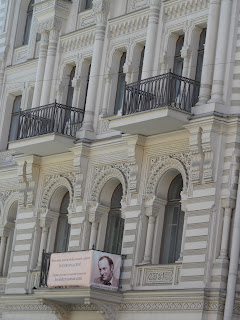This post continues on the theme from the last post of finding new places in St. Petersburg. It's a fun (and free!) way to spend some of our extra time in the summer. I am still tutoring and we are still helping out with baseball, in addition to working on things for the coming school year, but we still have time to enjoy some of the sites we haven't seen yet from our beautiful city.
These pictures come from a long walk that I took last week as well as from earlier today when Amanda and I headed off to the area around the Chernyshevskaya metro station to find a few more places listed in our book.
I'll post the pictures in the order we went and provide some commentary. As always, click on the photos to see them in better detail:-)
This is a water tower on an old factory that is no longer in use. It's actually on the island that we live on, and I had seen several times before but it was included in the guidebook that we have been going through, so I thought I would stop by and take a few pictures.
From the front view, you can't tell immediately that it isn't completely solid, which is what makes the tower striking from an architectural standpoint.
This is the main synagogue for St. Petersburg's Jewish community. It is a beautiful building and the design in the iron fence is very striking as well. The synagogue is just one example of some of the striking non-Christian religious architecture in the city in addition to the main mosque (which we have posted pictures of before) and a large Buddhist temple which we haven't had a chance to visit yet.
a closer view of the central part of the synagogue and of the iron entry way at the bottom.
The Church of Sts. Isidor and Nicholas sits alongside Griboyedov Canal and has been one that I've wanted to take pictures of for a while but hadn't made the time to. The church was originally built for the Estonian community of Orthodox Christians in 1907.
A closer-up view of the church.
The Lomonosov Bridge is a stone bridge that originally dates back to the late 1700s.
This building was built in a Moorish style and in addition to its striking design is significant for being the home and meeting place of a number of the leading Russian writers of the Silver Age of Russian poetry which took place during the first two decades of the 20th century.
This view gives a better look at the detailed facade of the building. Also, on the balcony is a sign for a museum for Joseph Brodsky, the famous Russian poet who left the Soviet Union in the 1970s and settled in the United States and later won the Nobel Prize for literature, who lived in this building for 30 years.
Another gorgeous building with a detailed facade that we came across. It was built in the 1870s. The bright sunlight unfortunately obscures a bit of the fine details on the front of this building.
The next series of photographs all come from the same place and were the original part of the guidebook that we have been going through that caught my eye. Tucked away unassumingly in a courtyard is the Malaya Art Institute, and people from the institute have decorated the walls and a playground/park in the courtyard with beautiful mosaics.
It's me!
An unusual sculpture-type thing forms the backdrop to a group of benches covered in mosaics. In the center is a mosaic fountain. Unfortunately, it is undergoing restoration and is not visible.
The bottom portion of two outside walls of an adjoining building are also covered in mosaics.
This is the Malaya Institute building itself.
One entire side of the building is covered with the most elaborate and colorful of all of the mosaics.
Amanda!
This and the next several photos are of a building done with Egyptian-style designs. It dates back to the early 20th century.
This building, with its striking four-tiered tower, was also the home of important gatherings of intellectuals during the early 20th century. A plaque of the side commemorates its significance for the leading poets, artists, and philosophers of the pre-Revolutionary era.
This church, located close to the building above, was built in the early 1900s, but its appearance is similar to many of the traditional Russian churches of the 11th-14th centuries that can be found in older cities like Novgorod and Pskov.
We hope to go out and find a few more places in the time that we have left before school resumes. Our teacher meetings will be taking place shortly and August 22nd is the first day of school so summer is beginning to come to an end for us. We'll have more about the upcoming school year later, but for now we'll continue to enjoy the last part of our break before the excitement of the new year begins.
-Matt










































No comments:
Post a Comment